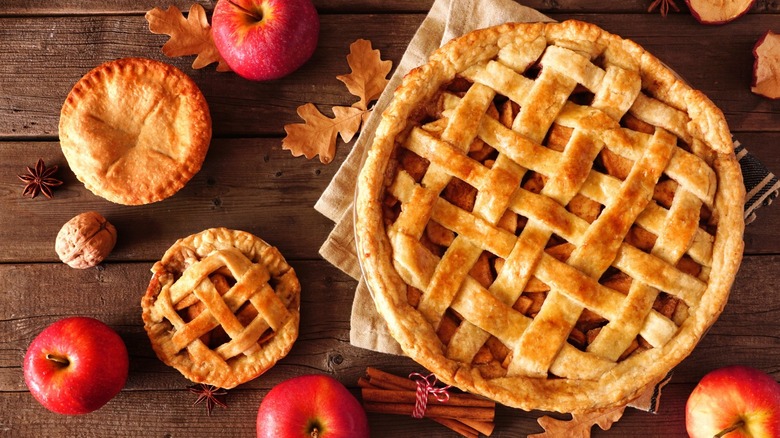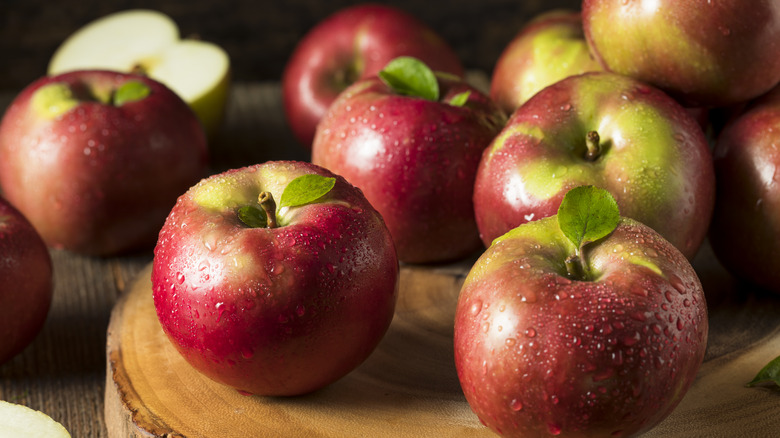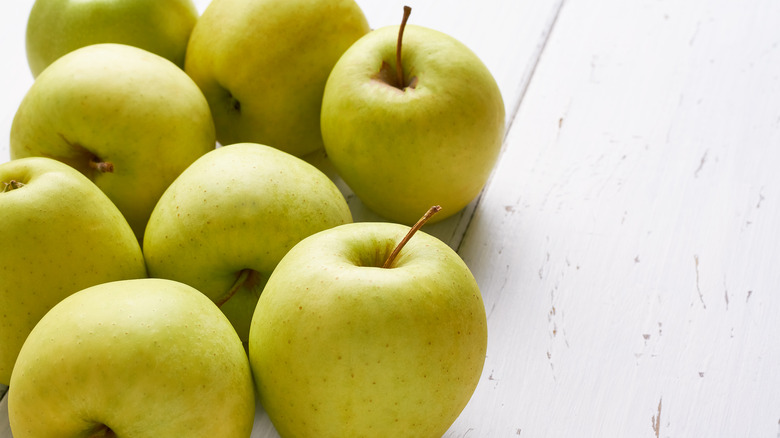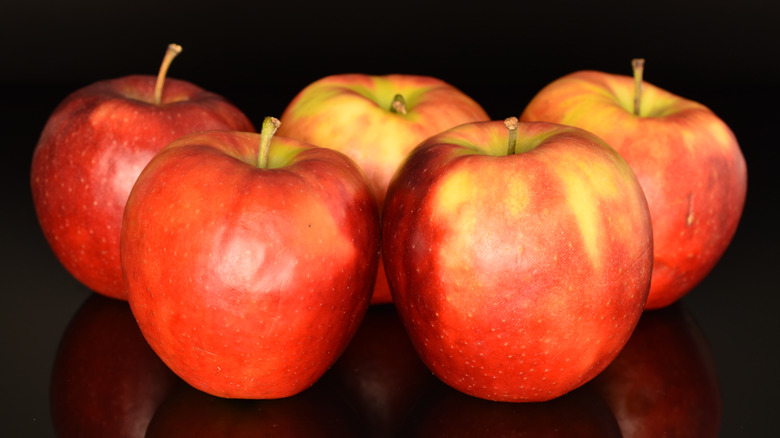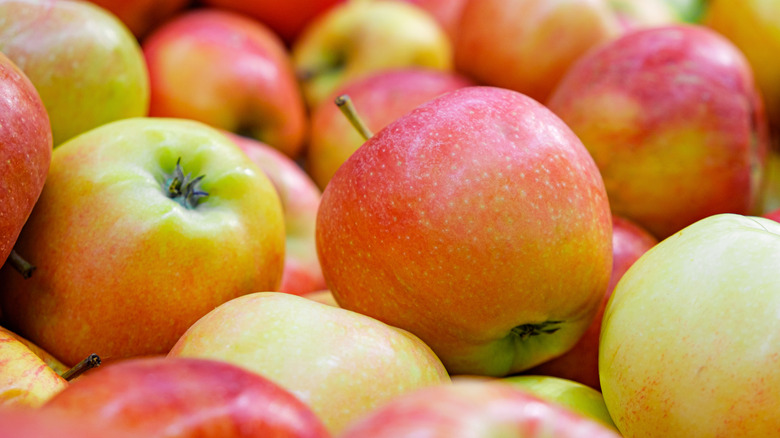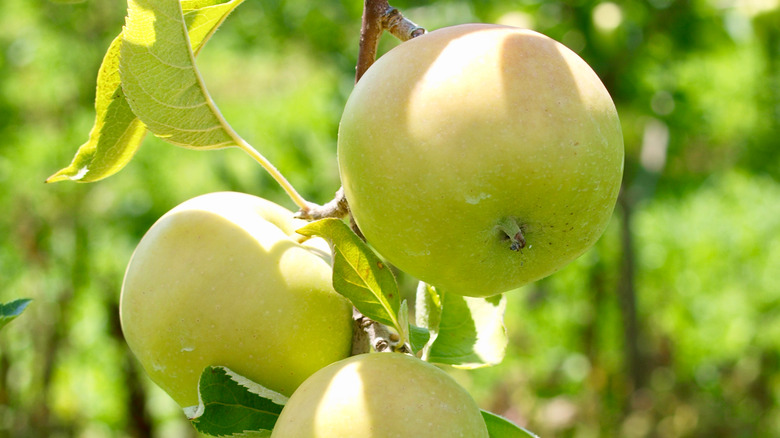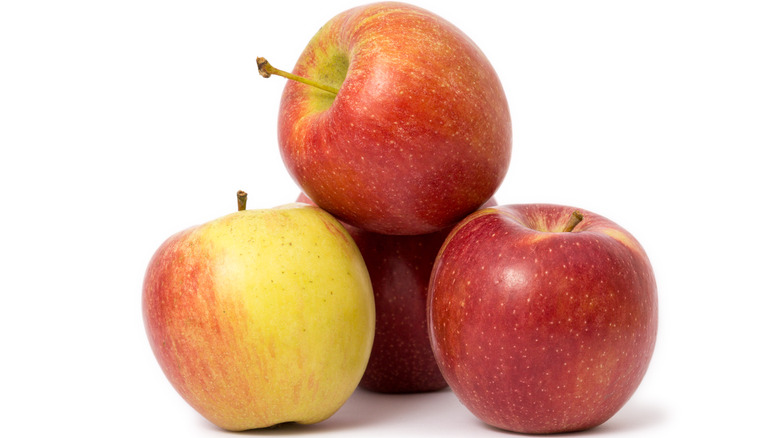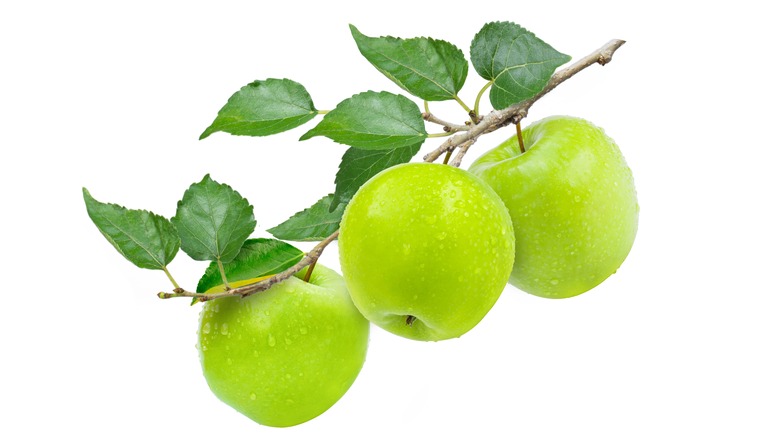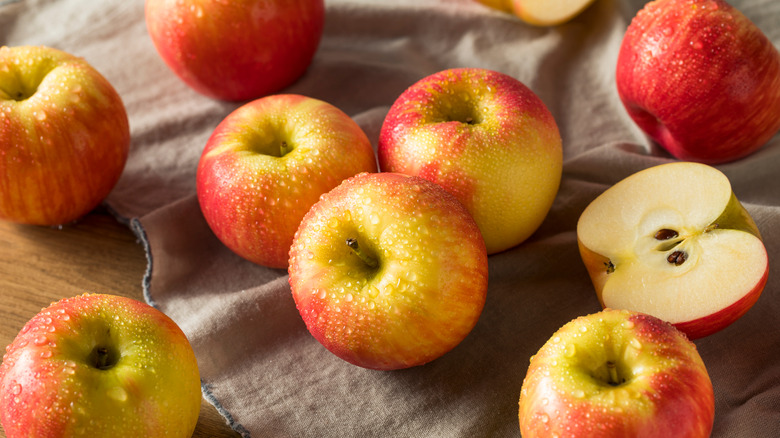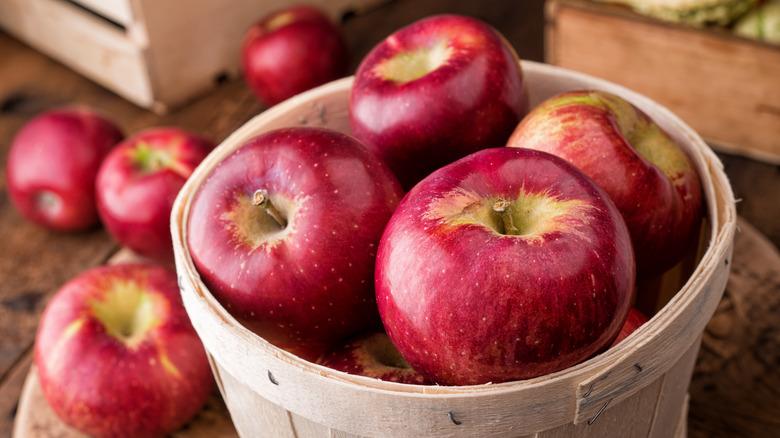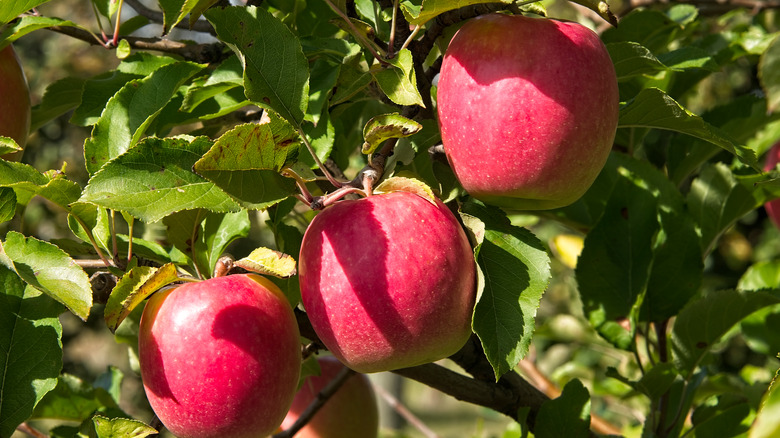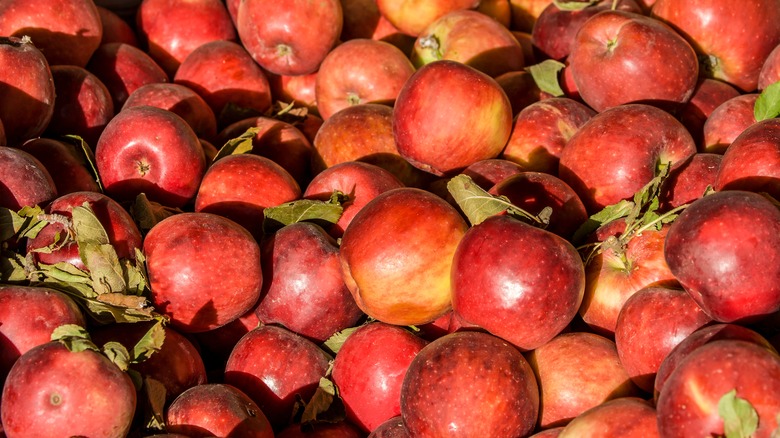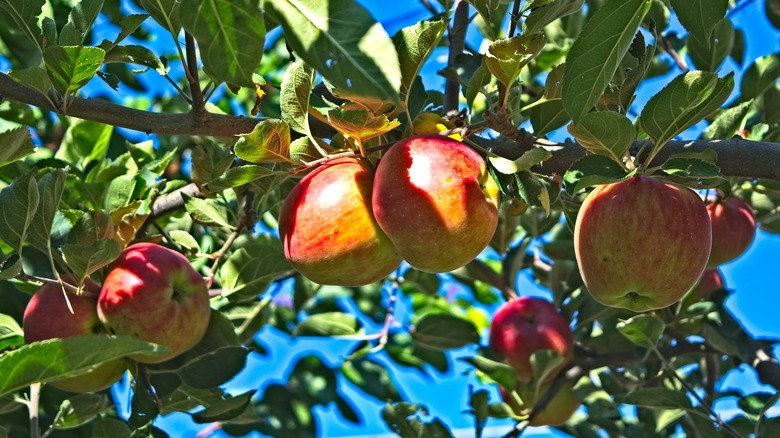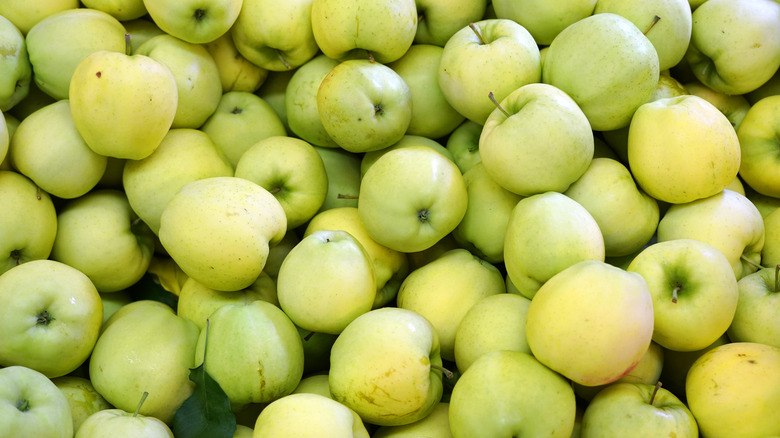The 13 Best Types Of Apples For Baking
Undoubtedly, one of the best things to do with apples is turn them into baked goods. A classic homemade apple pie, baked apples (even better with cinnamon), and a simple five-ingredient apple crisp are a few of the many delectable treats made with this delicious fruit. However, not all varieties are ideal for baking. In the world of apples, there is so much variation, from size and color, to texture and shape.
For example, if you're looking to craft the perfect pie, with the perfect crust, your apples need to have the right flavor. They need to cook down enough to soften, but not so much that you are left with applesauce. No one wants a sloppy or mealy apple pie. Plus, different varieties are in season at different times, so finding the right fruit can also vary depending on what time of year you're baking (via Soergel Orchards). While many of the apples you find in the grocery store are excellent for eating, they simply won't cut it for your next baking project. Whether you are looking to use a single apple or a mix, we have compiled a list of the best types of apples for baking.
McIntosh
The McIntosh is the way to go if you are looking for a widely available apple that is perfect for almost any baking project. First discovered in Canada in 1811 by John McIntosh, the McIntosh apple is one of the most popular for making desserts, according to Apple Holler. In addition, the McIntosh apple offers a flavor that is just a little tart, with a taste reminiscent of apple cider (via Specialty Produce).
McIntosh apples are a little softer than other varieties, and while this means they are more easily damaged in transport, it also means they require a shorter baking time compared to other apples. This can be a bonus if you are looking to shave time off your project, but it should be taken into consideration if you are planning to mix different kinds of apples into one bake.
McIntosh apples come into season in early September and are available throughout the winter.
Golden Delicious
Delicious apples get a bad rap due to the fact that many people don't find Red Delicious apples all that delicious. However, don't knock all apples under the Delicious name. The Golden Delicious apple both lives up to its moniker and makes an excellent baking apple.
The Golden Delicious was first discovered in the early 20th century in West Virginia. According to CMI Orchards, it is sweeter than its Red Delicious cousin, which often means that when used for baking you can be sparing with the sugar, allowing the natural sweetness of the fruit to shine through.
The Golden Delicious apple has a mellow flavor and a crisp but soft flesh. Between this and the sweet yet acidic nature, it is perfect for using in baking projects. The fruit does not brown quickly, and pairs wonderfully with popular apple baking spices, such as cinnamon. The Golden Delicious variety comes into season in the fall and can last until the spring, making it widely available.
Jonathan
The Jonathan apple is less widely available than some others. As an heirloom variety with an uncertain history, Jonathan apples did not initially gain commercial success (via Minneopa Orchards). However, they can still be found in the Midwest and Northeast of the United States.
The Jonathan apple isn't as crunchy as others but offers plenty of juice. According to Specialty Produce, the apple provides a sweet and mildly tangy flavor that also offers a bit of a spicy note.
The fruit itself breaks down quickly when cooked, making it an easy choice for a baked dessert like apple pie, or an apple and walnut pudding. Pair Jonathans with more robust varieties when using in an apple-heavy dish such as pie, but they can be used on their own in cakes. Unfortunately, Jonathan apples have a short window of availability, coming into season in late September and only usually being available in the fall.
Jonagold
A cousin of both the Golden Delicious and the Jonathan, the Jonagold brings the best attributes of both to form a nearly perfect baking apple.
The Jonagold arrived on the scene in the mid-20th century at the New York State Agricultural Experiment Station in Geneva, making it a newer apple than many others on this list, Stemilt Growers reports. It offers a sweet and tangy taste with notes of honey. It is a large fruit and will hold up well to baking, which Specialty Produce notes makes it a versatile baking apple. It can be used on its own, by hollowing and filling as a baked apple, or as the star ingredient in muffins, pies, or cakes.
Jonagolds are versatile and delicious, but they do have one major drawback: They have a relatively short season, which limits their availability. According to Soergel Orchards, they come into season in early October. So if you can find them in stores or at a farmers market, you can't go wrong.
Mutsu/Crispin
An apple with two names, the Mutsu is also sometimes called the Crispin. The apple was first sold in the Mutsu area of Japan in 1948, which is where the original name derives from (via Stemilt Growers). However, in the 1960s, there was a push to rename it Crispin, and now both names are used.
As a cross between a Golden Delicious and an Indo apple, the Mutsu is sweet and slightly tart in flavor, according to Soergel Orchard. While the apple is exceptionally juicy, it also offers a crisp and firm texture which makes it an excellent choice to use for baking, particularly when making baked apples or a perfect apple pie. They are large fruit with an orange tinged skin. While delicious and great for baking, Mutsu apples have a fairly limited availability, but you should be able to get hold of them in late September and October.
Braeburn
If you are looking for an apple with a more complex flavor than your standard Delicious and its variants, look no further than the Braeburn. The Braeburn apple was first grown by Braeburn Orchard in New Zealand in the 1950s (via Specialty Produce). The exact parentage is not known, as it was discovered by chance, and not purposely bred. Now, Orange Pippin reports the fruit has grown so popular it makes up 40% of all apples grown in New Zealand.
Braeburn apples have their flavor to thank for their success: They're spicy, with hints of cinnamon and nutmeg. Orange Pippin describes the flavor as being good enough to make other modern varieties feel "one dimensional."
To complement this fantastic flavor, the Braeburn cooks beautifully: It holds its shape well when cooked, and the taste slightly mellows, which makes it excellent for pairing with just about any sweet or savory baked dish. Braeburn apples are available from the fall through to spring, making them an easy choice for baking.
Granny Smith
If sweet apples aren't your thing and you want something that packs more of a punch, try the classic tart apple, the Granny Smith. While it has become a staple over time, if it wasn't for a bit of luck, we would not have the apple in our lives today. The variety was accidentally discovered in the 1860s by Maria Ann Smith, the real woman behind the Granny Smith name. She actually found the first Granny Smith seedling growing in her compost heap.
Granny Smith apples can best be described as tart. They are acidic and are one of the tangiest varieties easily available. They are well known as being an all-purpose apple and bake beautifully, adding a distinct flavor to any project you might be working on, like a baked apple pancake. Their green skin makes them easily recognizable and they can be found easily almost all year round (via Stemilt Growers).
Honeycrisp
Most people agree Honeycrisp apples taste really, really good. They were initially developed in the 1960s by the University of Minnesota's Agricultural Experiment Station as part of a project developing apples that could happily grow in cold weather (via Specialty Produce). The apple was released to the public for the first time in the 1990s and became a booming success.
The apples are medium in size and have a crisp texture. They offer a medium tang and are juicy and fruity in flavor, according to CMI Orchards. While they're great for eating on their own, they are also amazing for just about any kind of baking project, like a warming dish of baked apples with brown sugar and raisins.
The one major downside to Honeycrisp apples is their price. Due to a combination of factors, including being notoriously difficult and laborious to grow, Honeycrisp apples are more expensive than other varieties of apples. As their popularity has grown, they have become more widely available, though their primary season is fall to early winter.
Cortland
Cortland is one of the unsung heroes of baked apple desserts. It was first created by the New York State Agricultural Experiment Station in 1898 (via New York Apple Association) and in 1923 was awarded the Wilder Medal for contributions to apple cultivation. It is a cousin of the McIntosh, and after its release became one of the most popular apples in New York.
Cortland apples are initially crispy but lose much of their texture quickly. They are slightly tart but also sweeter than the McIntosh. Their mildly acidic flavor works well in baked goods, like pastry wrapped baked apples, bringing a wonderful fruity taste to any dish. However, after a lot of cooking they can become quite soft, so be careful not to use them in anything where they need to hold their shape. They work wonderfully paired with other varieties in a pie or in cakes, muffins, or cobblers. Cortland apples are available from fall to spring.
Pink Lady
Pink Lady is the trademarked brand name for Cripps Pink. John Cripps developed the apple for the Western Australia Department of Agriculture in the 1970s, and it's a cross between the Golden Delicious and Lady Williams.
The result is a fruit that has an aesthetically pleasing pink skin and a flavor that is both sweet and tart. The texture is crisp and the interior flesh of the apple is a pale white color that does not brown easily, keeping this apple beautiful for all baking needs.
Pink Lady apples can easily be used for topping delicate baked goods but they're also particularly good for pies. Tom Heflin, pie baker, and orchard owner, told SFGate that for his pies, he prefers Pink Lady apples. His reasoning is that their flavor and texture hold up better when compared to other varieties. Pink Lady apples are also widely available: They tend to appear in shops in November, but are often available all year round as they can be kept in storage for a long time.
Winesap
The Winesap apple is one of the oldest on this list. It is known as a heritage variety, with the first recorded mention of it dating back to 1804 (via Specialty Produce). The Winesap was grown commercially through the 20th century but eventually fell out of favor, with other apples taking the lead.
To this day, though, Winesap apples are grown, though typically in smaller orchards. They are currently used in the production of cider and hard cider blends. However, they can also be used in baking for a unique result. They offer a tough and crunchy flesh that holds its shape well during cooking. In addition, Winesap apples have a sweet and tangy flavor with notes of spices and wine. This heirloom apple will add a unique flavor to any baked good and is perfect for someone looking for a variety outside the typical grocery store fare. Winesaps are available starting in late fall and going through winter.
Northern Spy
Northern Spy is another heirloom variety. If you are looking for something to set your baked goods apart, this is the one. The apple was first planted in the early 1800s in New York by Herman Chaplin, according to Specialty Produce. It takes the tree longer to produce fruit than other varieties, but once it does, the apples grow large and are incredibly cold tolerant, making Northern Spy a good choice for a local option in chillier climates.
Northern Spy apples have a soft and pale yellow flesh and are juicy. They are more tart than sweet, with notes of cider and hints of pear in their flavor. Because of this, Northern Spy are often used in cider making. However, the apple can be used in a number of ways. One of the best ways to use it is for baking. It's particularly good for classic apple-heavy baked goods, such as pies and cobblers. Northern Spy are currently grown primarily in the Northeast and are available in the fall.
Ginger Gold
Golden Delicious are not the only gold apples in town. The Ginger Gold apple was cultivated by Clyde and Frances "Ginger" Harvey after a hurricane destroyed most of their orchard. The couple found the seedling and allowed it to grow. The resulting fruit offers a golden-green color, so they decided to name it for the color and for Frances Harvey, using her nickname, "Ginger" (via Specialty Produce).
The resulting fruit is sweet, with just a hint of tartness, says New York Apple Association. Most of the tartness is found just after picking and mellows as the apple ages. This apple has a fine, crisp texture that holds up well to baking. It can be used for baked apples, cakes, pies, or any other baked good that calls for sturdy fruit. Additionally, the Ginger Gold does not brown quickly and can be used as a fresh fruit topping for baked goods.
Ginger Gold apples are an early harvest fruit, available starting in late summer and going through the fall.
